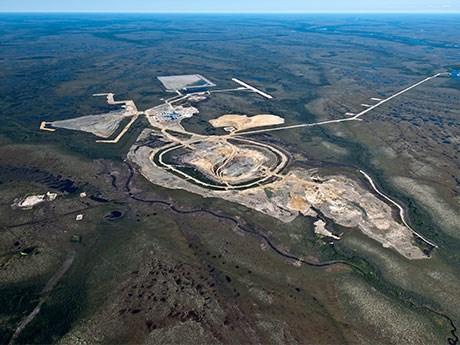De Beers Canada hasn’t made a decision to proceed with its Victor Mine Extension Project in Northern Ontario’s James Bay Lowlands, but has initiated an environmental assessment (EA) to expedite project development if the numbers add up and board approval is secured.
The company’s Victor Mine is located 90 kilometres west of the coastal community of Attawapiskat in a cluster of 18 kimberlite pipes, 16 of which are diamondiferous. The Extension Project, focused on the Tango pipe seven kilometres northwest of Victor, would begin producing ore in 2018, by which time the current pit is scheduled to be exhausted.
“The Tango Extension kimberlite, while smaller and of lower grade than Victor, currently offers the best potential to extend the life of the mining operation and the related economic benefits to local communities,” stated the company in an April press release announcing the initiation of the EA process.
De Beers spent close to $1 billion developing the Victor Mine and commenced production in 2008. The mine boasts an annual production capacity of 2.7 million tonnes and produces in the range of 600,000 carats annually.
The Tango pipe is expected to have a mine life of roughly seven years.
“The environmental process is anticipated to take approximately two years and will run in parallel with community consultation, further baseline environmental studies, engineering and evaluation of the Tango Extension resource,” according to the company. “If these activities prove favourable and are successfully concluded early in 2016, then De Beers will request development approval from our Board of Governors.”
One project, one review
The EA is being conducted in accordance with the Canadian Environmental Assessment Act of 2012, which supports the federal government’s Responsible Resource Development Initiative and the goal of “one project, one review in a clearly defined time period.”
A June 4 press release issued by the Canadian Environmental Assessment Agency (CEAA) set a July 4 deadline for public review and comments on the draft Environmental Impact Statement (EIS) guidelines, “a document identifying the potential environmental effects to be taken into consideration and the information and analysis that needs to be included in (De Beers’) EIS.”
The next step is to finalize and issue the EIS guidelines to De Beers. An application period for participant funding and a future public comment period for the EIS will follow.
According to Tom Ormsby, De Beers’ director of external and corporate affairs, it’s too early to estimate project costs.
“All of that is still being worked out,” he said. “We’re not there yet.” “We initiated the environmental assessment because we have five years left on the current Victor Mine and we believe it might take that long to go through the environmental piece. It may be some time before we make a final decision on whether or not we can extend the life of the mine based on this other pipe.”
Varying amounts of work have been done on the other 14 diamondiferous pipes in the cluster, said Ormsby.
“Victor was the biggest so that’s why we started there. The others have been drilled, but not to the same extent. We’re focusing on Tango because that’s the one that seems to have the most promise.”


